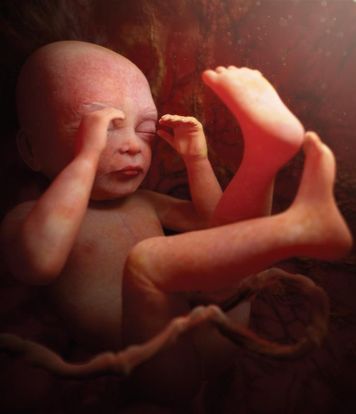23 weeks and 2 days pregnant

You will probably be aware of your baby’s movements by now: the number of movements and their nature will vary during the day and night and you may notice that they start to form into a particular pattern or respond to your own activity.
With a layer of fat and a tough layer of cells, your baby’s skin is now becoming more resilient.
Your baby’s skin is continuing to develop and has now started to “keratinize”. Keratin is the substance that transforms the skin’s outer layer into a protective layer of dead cells. Hair and nails also form from keratin.
The outer keratinized layer of skin cells, plus a layer of fat laid down between the skin cells, gives the skin a waterproof covering. This process of keratanization reduces the amount of water your baby loses into the amniotic fluid. Each new skin cell, made in the deepest part of the skin, matures as it gradually moves up towards the surface and, now keratinized, becomes part of the outer protective layer before it is eventually shed. The cycle takes approximately 30 days.
The thickest layers of keratinized cells are on the palms of the hands and the soles of the feet. The keratinizing process has only just begun. As the fat layer is very thin at this stage, your baby’s skin will still appear translucent, but less so than it did in earlier weeks.
At this stage of pregnancy, your baby still has plenty of room to manoeuvre inside the uterus, and although you’re likely to be feeling lots of movements by now this will only be a fraction of the total. This is because the only movements you’ll feel are those that cause your baby to kick or bump into the wall of your uterus. You will be unaware of many of the finer movements that are performed close to the baby’s body as they won’t make any contact with your uterus.

Your baby’s bones are hardening and her arms and legs are beginning to flesh out. She brings her hands to her face often. Her skin is starting to develop a protective outer covering of vernix.
Getting painful spasms in the leg muscles is common in pregnancy, particularly at night. You may find that you wake up due to the sudden and severe localized pain in your legs or feet. This is thought to be due to the pressure of the uterus on the pelvic nerves.
Some experts believe that cramp during pregnancy may be caused by a lack of calcium or salt or an excess of phosphorus, but these theories are as yet unproven.
When you get a spasm, relieve it by flexing your foot or leg, and gently massaging the affected area. The cramp should resolve itself once you are out of bed and using the muscle. However, if the pain doesn’t recede and there is any reddening or swelling in the leg, you should seek medical advice urgently to eliminate the possibility of a clot, as this can be dangerous.
To reduce the incidence of cramp or its severity, drink lots of water to prevent dehydration and regularly do leg stretches and ankle exercises, circling your heel and wiggling your toes.
Doing gentle exercise, such as walking or swimming, can also help, as can regularly massaging the calf muscle to improve circulation.

Gently flex your foot to relieve cramp in the calf muscle. Alternatively, do a calf stretch.
Be the first to support
Be the first to share
Comment (0)
Related Blogs & Vlogs
No related events found.
Loading more...